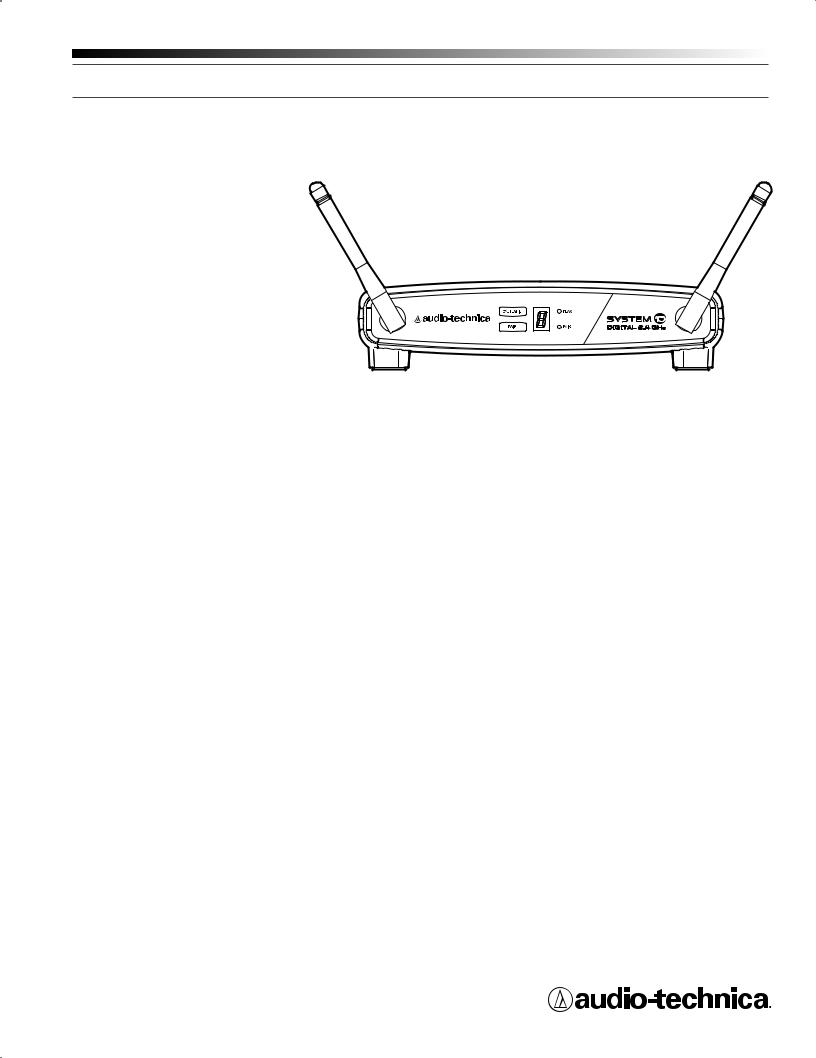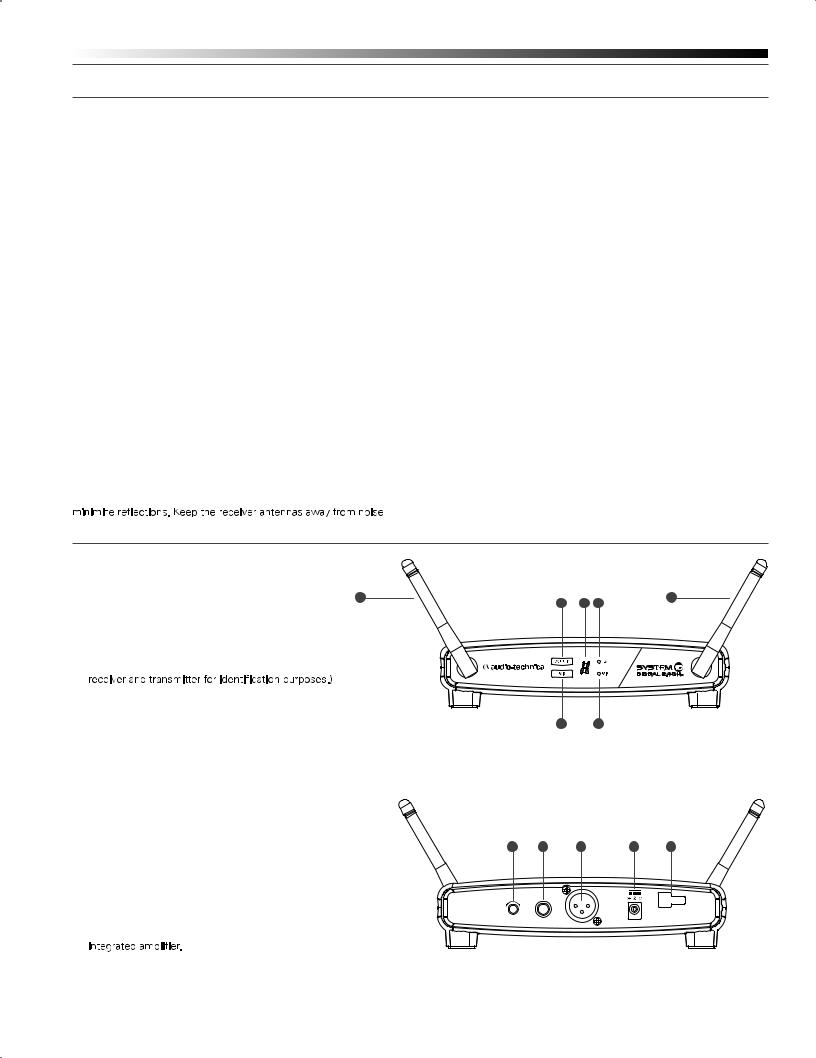Audio Technica ATW-1101G, ATW-1101H, ATW-1101H92, ATW-1101H92-TH Installation and Operation

System 10
Digital Wireless System
Installation and Operation
ATW-1101
UniPak® Transmitter System
ATW-1101/G
Guitar System
ATW-1101/H
Headworn Microphone System
ATW-1101/H92
Miniature Headworn Microphone System
ATW-1101/H92-TH
Miniature (beige) Headworn Microphone System
ATW-1101/L
Lavalier Microphone System
ATW-1102
Handheld Microphone System

2
System 10 Installation and Operation
CAUTION
RISK OF ELECTRIC SHOCK
DO NOT OPEN
WARNING: TO REDUCE THE RISK OF FIRE OR ELECTRIC SHOCK, DO NOT REMOVE SCREWS. NO USER-SERVICEABLE PARTS INSIDE. REFER SERVICING TO QUALIFIED SERVICE PERSONNEL.
WARNING: TO REDUCE THE RISK OF FIRE OR ELECTRIC SHOCK, DO NOT EXPOSE THE APPLIANCE TO RAIN OR MOISTURE.
CERTIFICATION: THE ATW-1101 COMPLIES WITH PART 15 OF THE FCC RULES. THIS DEVICE COMPLIES WITH INDUSTRY CANADA LICENSE-EXEMPT RSS STANDARD(S). OPERATION IS SUBJECT TO THE FOLLOWING TWO CONDITIONS: (1) THIS DEVICE MAY NOT CAUSE HARMFUL INTERFERENCE, AND (2) THIS DEVICE MUST ACCEPT ANY INTERFERENCE RECEIVED, INCLUDING INTERFERENCE THAT MAY CAUSE UNDESIRED OPERATION.
Le ATW-1101 conforme à la/aux norme(s) RSS exempte(s) de licence d’Industrie Canada. Son fonctionnement est soumis aux deux conditions suivantes : (1) cet appareil ne doit pas causer d’interférence et (2) cet appareil doit accepter toutes les interférences, y compris celles susceptibles de provoquer un fonctionnement non souhaité.
WARNING: Changes or modi cations not expressly approved in writing by Audio-Technica may void the user’s authority to operate this equipment.
RF Exposure Statement: This transmitter must not be co-located or operated in conjunction with any other antenna or transmitter.
The ATW-R1100 complies with FCC/IC radiation exposure limits set forth for an uncontrolled environment and meets the FCC radio frequency (RF) Exposure Guidelines and RSS-102 of the IC radio frequency (RF) Exposure rules. This equipment has very low levels of RF energy that it deemed to comply without maximum permissive exposure evaluation (MPE). But it is desirable that it should be installed and operated keeping the radiator at least 20cm or more away from a person’s body.
Le ATH-R1100 conforme aux limites d' exposition aux rayonnements énoncées pour un environnement non contrôlé et respecte les règles d' exposition aux fréquences
radioélectriques (RF) CNR-102 de I'IC. Cet équipement émet une énergie RF très faible qui est considérée conforme sans évaluation de l' exposition maximale autorisée. Cependant, il est souhaitable qu'il devrait être installé et utilisé en gardant une distance de 20 cm ou plus entre le dispositif rayonnant et le corps.
The available scienti c evidence does not show that any health problems are associated with using low power wireless devices. There is no proof, however, that these low power wireless devices are absolutely safe. Low power Wireless devices emit low levels of radio frequency energy (RF) in the microwave range while being used. Whereas high levels of RF can produce health effects (by heating tissue), exposure of low-level RF that does not produce heating effects cause no known adverse health effects. Many studies of lowlevel RF exposures have not found any biological effects. Some studies have suggested that some biological effects might occur but such ndings have not been con rmed by additional research. ATW-T1001, ATW-T1002 has been tested and found to comply with FCC/IC radiation exposure limits set fourth for an uncontrolled environment and meets the FCC radio frequency (RF) Exposure Guidelines and RSS-102 of the IC radio frequency (RF) Exposure rules.
Les connaissances scienti ques dont nous disposons n’ ont mis en évidence aucun probième de santé associé à l' usage des appareils sans l à faible puissance. Nous ne sommes cependant pas en mesure de prouver que ces appareils sans l à faible puissance sont entièrement sans danger. Les appareils sans l à faible puissance émettent une énergie radioélectrique (RF) très faible dans le spectre des micro-ondes lorsque' ils sont utilisés. Alors qu' une dose élevée de RF peut avoir des effets sur la santé (en chauffant les tissus), l' exposition à de faibles RF qui ne produisent pas de chaleur n' a pas de mauvais effets connus sur la santé. De nombreuses études ont été menées sur les expositions aux RF faibles et n' ont découvert aucun effet biologique. Certaines études ont suggéré qu'
il pouvait y avoir certains effets biologigues, mais ces résultats n’ ont pas été con rmés par des recherches supplémentaires. ATW-T1001, ATW-T1002 a été testé et jugé conforme
aux limites d' exposition aux rayonnements énoncées pour un environnement non contrôlé et respecte les règles les radioélectriques (RF) de la FCC lignes directrices d'exposition et d' exposition aux fréquences radioélectriques (RF) CNR-102 de l' IC.
Note: This equipment has been tested and found to comply with the limits for a Class B digital device, pursuant to part 15 of the FCC Rules. These limits are designed to provide reasonable protection against harmful interference in a residential installation. This equipment generates, uses and can radiate radio frequency energy and, if not installed
and used in accordance with the instructions, may cause harmful interference to radio communications. However, there is no guarantee that interference will not occur in a particular installation. If this equipment does cause harmful interference to radio or television reception, which can be determined by turning the equipment off and on, the user is encouraged to try to correct the interference by one or more of the following measures:
-Reorient or relocate the receiving antenna.
-Increase the separation between the equipment and receiver.
-Connect the equipment into an outlet on a circuit different from that to which the receiver is connected.
-Consult the dealer or an experienced radio/TV technician for help.
This Class B digital apparatus complies with Canadian ICES-003.
Cet appareil numerique de la classe B est conforme a la norme NMB-003 du Canada.
CAUTION! Electrical shock can result from removal of the receiver cover. Refer servicing to quali ed service personnel. No userserviceable parts inside. Do not expose to rain or moisture. The circuits inside the receiver and transmitter have been precisely adjusted
for optimum performance and compliance with federal regulations. Do not attempt to open the receiver or transmitter. To do so will void the warranty, and may cause improper operation.
Notice to individuals with implanted cardiac pacemakers or AICD devices:
Any source of RF (radio frequency) energy may interfere with normal functioning of the implanted device. All wireless microphones have low-power transmitters (less than 0.05
inches away. However, since a “body-pack” mic transmitter typically is placed against the body, we suggest attaching it at the belt, rather than in a shirt pocket where it may be immediately adjacent to the medical device. Note also that any medical-device disruption will cease when the RF transmitting source is turned off. Please contact your physician or medical-device provider if you have any questions, or experience any problems with the use of this or any other RF equipment.
Important Safety Instructions
1.Read these instructions.
2.Keep these instructions.
3.Heed all warnings.
4.Follow all instructions.
5.Do not use this apparatus near water.
6.Clean only with a dry cloth.
7.Install in accordance with the manufacturer’s instructions.
8.Do not install near any heat sources such as radiators, heat registers, stoves, or other
9.Unplug this apparatus during lightning storms or when unused for long periods of time.
10.
apparatus has been damaged in any way, such as power-supply cord or plug is damaged, liquid has been spilled or objects have fallen into the apparatus, the apparatus has been exposed to rain or moisture, does not operate normally, or has
been dropped.
Thank you for choosing an Audio-Technica professional wireless
have chosen our products because of their quality, performance and reliability. This wireless microphone system is the successful result of years of design and manufacturing experience.
Audio-Technica’s System 10 is an eight-channel digital wireless system designed to provide rock-solid performance along with easy setup and clear, natural sound quality. Featuring stackable, contemporary styling, System 10 is available in handheld, headworn, guitar, lavalier
TV and DTV interference, System 10 offers extremely easy operation and instantaneous channel selection. Up to eight channels may be used together without any frequency coordination problems or group selection issues.
System 10 wireless ensures clear communications by providing three levels of diversity assurance: frequency, time, and space. Frequency Diversity sends the signal on two dynamically allocated frequencies for interference-free communication. Time Diversity sends the signal in multiple time slots to maximize immunity to multipath interference. Finally, Space Diversity uses two antennas on each transmitter and receiver to maximize signal integrity.

3
System 10 Installation and Operation
Each System 10 professional digital wireless system includes a receiver and either a body-pack transmitter or a handheld microphone/ transmitter. ATW-1101 UniPak® body-pack transmitter systems include models pre-packaged with either an AT-GcW guitar cable (/G), a
PRO 8HEcW headworn microphone (/H), a PRO 92cW headworn microphone (/H92), a PRO 92cW-TH headworn microphone (/H92TH), or an MT830cW lavalier mic (/L) for particular applications. All A-T Wireless Essentials® microphones and cables, available separately, are pre-terminated for use with any ATW-1101 system.
Because System 10 packaging is designed to hold all versions
of the system, some compartments in the carton may be intentionally left empty.
The ATW-R1100 receiver includes a switching power supply that automatically adapts to changes in mains voltage.
The versatile ATW-T1001 UniPak® body-pack transmitter has both
a high-impedance input for instruments, and a low-impedance input with bias connection for use with dynamic and electret condenser microphones. The ATW-T1002 handheld transmitter features a unidirectional dynamic microphone element.
Both the body-pack and handheld transmitters use internal AA batteries and have Power/Mute switches and input Trim (level) adjustments.
Receiver Installation
Location
For best operation the receiver should be at least 3' (1 m) above the ground and at least 3' (1 m) away from a wall or metal surface to
sources such as other digital equipment, microwave ovens, as well as
away from large metal objects. Keep System 10 receiver 30' (9 m) away from wireless access points. In multi-channel systems, position receivers at least 3' (1 m) apart and keep operating transmitters at least 6' (2 m) from the receivers to help assure maximum RF performance.
Output Connection
There are two audio outputs on the back panel: balanced XLR-type output and unbalanced ¼" TRS phone jack. Use shielded audio cable for the connection between the receiver and the mixer. If the input of the mixer is a ¼" jack, connect a cable from the ¼" unbalanced audio output on the back of the receiver housing to the mixer. If the input of the mixer is an XLR-type input, connect a cable from the balanced XLR-type audio output on the back panel to the mixer.
Power Connection
Connect the DC plug on the included AC power adapter to the DC power input on the back of the receiver. Secure the cord over the cord hook on the back of the receiver, to keep the plug from being detached by an accidental tug on the cord. Then plug the adapter into a standard 120 Volt 60 Hz or 230 Volt 50 Hz (depending on global location) AC power outlet.
(Note that the receiver has no power Off/On switch. The receiver will be energized whenever the power adapter is connected and plugged into the AC outlet. Unplug the power supply from the AC outlet when the system is not in use — both for safety, and to conserve energy.)
Antennas
Rotate the permanently attached antennas in the shape of a “V” (both 45° from vertical) for best reception.
ATW-R1100 Receiver Controls and Functions
1
Figure A — Front Panel Controls and Functions
1.Antennas: Position the antennas as shown.
2.System ID Select Switch: Press to cycle through System ID numbers. (System ID is an identical number assigned to a paired
3.System ID Display: Shows System ID number.
4.Pairing Switch: Press to initiate pairing.
5.AF Peak Indicator: Only lights when audio distortion is present at maximum modulaton. Not affected by position of Volume control.
6.Pair Indicator: Glows green to indicate presence of paired transmitter. Also blinks green to indicate pairing mode activated.
Figure B — Rear Panel Controls and Functions
1.AF Level (Volume) Control: Adjusts audio output level of both AF Output jacks; maximum output is fully clockwise.
2.Unbalanced Audio Output Jack: ¼" phone jack. Can be connected to an unbalanced aux-level input of a mixer, guitar amp or tape recorder.
3.Balanced Audio Output Jack: XLRM-type connector. A standard 2-conductor shielded cable can be used to connect the receiver output to a balanced microphone-level input on a mixer or
4.Power Input Jack: Connect the DC plug from the included in-line AC adapter.
5.Cord Hook: Loop the cord around the cord hook to keep the DC plug from pulling out accidentally.
2 |
3 |
5 |
1 |
|||||||||||
|
|
|
||||||||||||
|
|
|
|
|
|
|
|
|
|
|
|
|
|
|
4 6
1 |
2 |
3 |
4 |
5 |
MIN. MAX. |
|
|
|
|
VOLUME |
UNBALANCED |
|
DC 12V IN |
|
|
|
BALANCED |
500mA |
|
